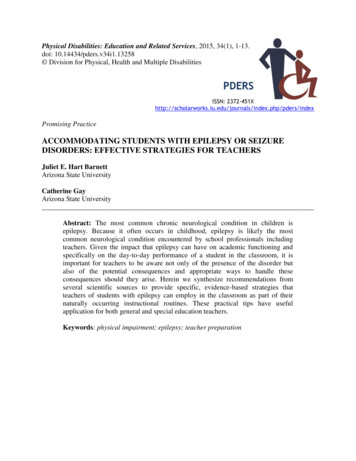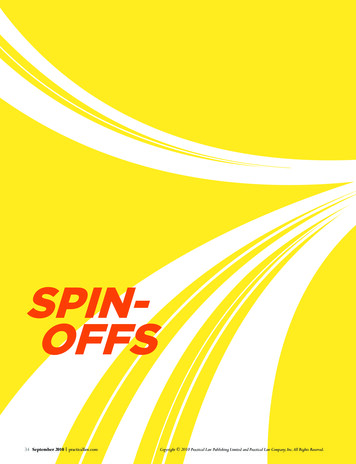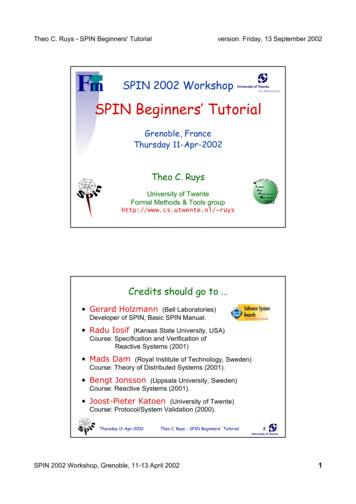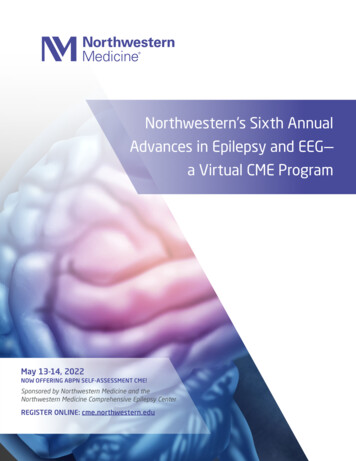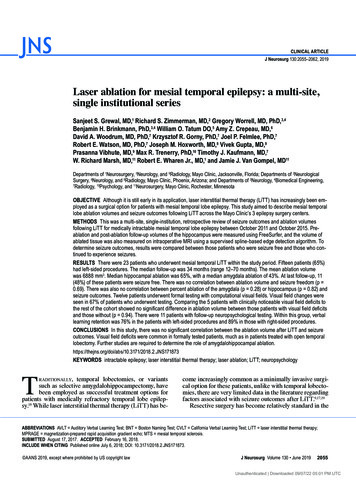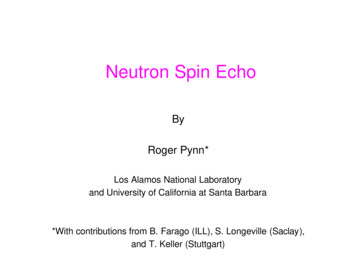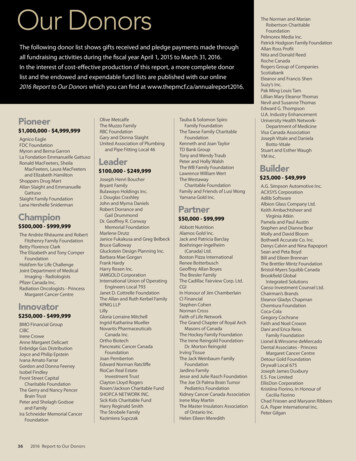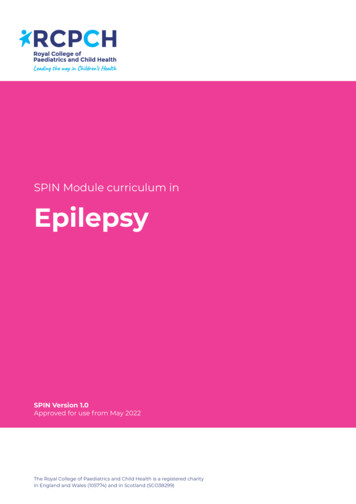
Transcription
SPIN Module curriculum inEpilepsySPIN Version 1.0Approved for use from May 2022The Royal College of Paediatrics and Child Health is a registered charityin England and Wales (105774) and in Scotland (SCO38299)
This document outlines the curriculum and assessment strategy to be used by paediatricianscompleting the RCPCH SPIN module in Audiovestibular Medicine.This is Version 1.0. As the document is updated, version numbers will be changed, and contentchanges noted in the table below.Version numberDate issuedSummary of changesThis information is correct and up to date at time of publication. RCPCH 20222
Table of ContentsSection 1 Introduction and purpose.4Introduction to SPIN modules.5Purpose statement. 6Requirements to undertake this SPIN module. 9#VoiceMatters. 12Ensuring fairness and supporting diversity. 16Quality assurance and continual improvement. 17Section 2 Paediatric Oncology. 19How to use the RCPCH SPIN curriculum. 20Components of the SPIN curriculum. 20SPIN Learning Outcomes. 21SPIN Learning Outcome 1. 22Key Capabilities. 22Illustrations. 22SPIN Learning Outcome 2. 23Key Capabilities. 23Illustrations. 23SPIN Learning Outcome 3. 25Key Capabilities. 25Illustrations. 25SPIN Learning Outcome 4. 26Key Capabilities. 26Illustrations. 26SPIN Learning Outcome 5. 27Key Capabilities. 27Illustrations. 27SPIN Learning Outcome 6. 28Key Capabilities. 28Illustrations. 28Section 3 Assessment Strategy.How to assess the Epilepsy SPIN.Assessment blueprint.Appendices.Appendix A: Further guidance and resources.Appendix B: Criteria for SPIN delivery.3293031343536
Section 1Introduction andpurpose
RCPCH SPIN module in EpilepsyIntroduction to SPIN modulesSpecial Interest (SPIN) modules are the additional training/ experience a paediatriciancompletes so that they can be the local lead and part of the clinical network providing forchildren who need specialist paediatric care. They are designed to meet a specific serviceneed, with possible roles suitable for those who have completed a SPIN module identifiedwithin the SPIN purpose statement.Paediatricians will be able to seek training in an area of special interest or in aspect(s) of subspecialty care. This will involve training, assessment and supervised care. It will vary in breadthand depth, depending upon the specific SPIN syllabus. The SPIN can be completed before or afterCCT. It should be feasible to complete the SPIN in no more than 12 months full time training. SPINtraining does not have to be completed within one placement or over one continuous period.The assessment of whether the clinician has attained the required learning outcomes will onlyexamine evidence relating to a maximum of five calendar years prior to submission.Please note that SPIN Modules are: NOT a route to GMC sub-specialty accreditation.NOT required for GMC accreditation in Paediatrics or any of its subspecialties. NOT sub-specialty training and not equivalent to subspecialty training.SPINs are undertaken and assessed within the working environment, under the guidance of adesignated Supervisor, recording evidence within the ePortfolio. The RCPCH SPIN Lead, usually amember of the relevant College Specialty Advisory Committee (CSAC), is responsible for reviewingcompleted portfolios and confirming if the SPIN is to be awarded.More information regarding SPIN Modules, including how to apply to undertake a SPIN andhow to submit evidence against the capabilities, is contained in the SPIN module guidance onthe RCPCH SPIN webpages: www.rcpch.ac.uk/spin5
Purpose statementThis purpose statement demonstrates the need for clinicians to undertake a SPIN modulein Epilepsy, the benefits to and expectations of a clinician undertaking training in this area.This SPIN module meets the current and future anticipated requirements of thehealth service, reflecting patient and population needs:Paediatricians increasingly work as part of wider clinical networks. By supporting themin developing an interest in a specific area of practice, SPINs help facilitate more patients beingseen by a paediatrician with the expertise to treat certain specific conditions nearer to theirhome, rather than having to travel to a major paediatric unit.Epilepsies in childhood are common affecting 0.5-1% of those under 18y of age. Misdiagnosisrate in childhood epilepsies is thought to be up to 30%, which exposes children and young peopleto the risks of both over and under-diagnosis. In England there have been significant failingsrecognised in the past in certain centres in Paediatric epilepsy care, and this led to theintroduction of focused epilepsy training, SIGN and NICE guideline development and emphasison the need for a SPIN module. The best way of preventing the repeat of these failings andpromoting good practise is through the targeted delivery of epilepsy education and training toclinicians managing young people. While a small percentage of these children may requirespecialist assessment, with the appropriate structures in place locally, the vast majority of thesechildren can be safely managed with care delivered close to their place of residence.Furthermore, workforce evaluations in Paediatric Neurology have consistently revealed ashortage of Consultant Paediatric Neurologists (CPNs). There are long waiting times atspecialist units following initial referral of a new patient with Epilepsy.Training individuals through SPIN in Epilepsy will ensure that each district general hospital hasa Paediatrician with a Special Interest in Epilepsy. This will: empower these clinicians to improve diagnostic certainty for the range of paroxysmal eventsseen in childhood. ensure appropriate use of at the DGH of specialist investigations such as EEG and neuroimaging.ensure the appropriate introduction and discontinuation of anti-epileptic medication for eachindividual patient. ensure patients and parents understand the risks and benefits of these medications.ensure referrals to specialist units are appropriate, decreasing waits for those who need itmost and ensuring those with complex needs are recognised and referred.6
This SPIN module considers interdependencies across related specialties anddisciplines, and has been developed and supported by the relevant key stakeholders.This SPIN module has been supported by the Neurology CSAC, in conjunction with: British Paediatric Neurology Association (BPNA) Paediatric Epilepsy Training (PET) Steering Committee British Paediatric Epilepsy Group (BPEG) Epilepsy Action Charity Neurology and Neurodisability Grid TraineesThe SPIN module supports flexibility and the transferability of learning, andprovides a clearly defined professional role for clinicians who have completed aSPIN. The SPIN module sets out what patients and employers can expect fromclinicians, who have gained the SPIN:Following successful completion of this SPIN module and level 3 Paediatric specialty training,the CCT holder will be competent to take up a post as a Consultant Paediatrician with a specialinterest in Epilepsy.By the end of training, it is expected that clinicians who have completed this SPIN will have asound understanding of: the terms seizure, epilepsies, epilepsy syndromes and be able to provide a structuredclassification of different seizure types and demonstrate awareness of the commonestepilepsies across all the different ages (e.g. neonates, infancy, childhood and adolescence).the neurobiology of seizure disorders and the common causes of seizures, including thecommon structural causes, the genetic mechanisms that contribute to seizures and thespecific age-related seizure syndromes. febrile seizures, their classification and differential diagnoses and management.the differential diagnoses for the range of paroxysmal events, both diurnal and nocturnal, andbe clear on how to distinguish epileptic seizures from non-epileptic seizures and other events. how the seizure semiology may be linked to focal onset of specific presentations.the management of a first seizure, non-epileptic events. psychogenic seizures, as well as howto manage status epilepticus.the indication, selection and side effects of anti-epileptic medication treatment as well how toswitch between medication, when and how to stop treatment.prescribing these medications in special circumstances such as relating to genderand pregnancy or specific organ failure (e.g. chronic kidney disease).pathways and indication for assessment for non-drug management (e.g VNS, ketogenic diet,lesional and non-lesional epilepsy surgery).the role and interpretation of EEG and other specialist neurophysiology, when to order whatimaging (CT, MRI and functional imaging).the risks of seizures (SUDEP, first aid advice) and the co-morbidities (autism, ADHD, LD etc)associated with seizures and how to offer and access advice. The SPIN training will enable them to undertake the following roles: 7independently and competently assess and manage new referrals of children and youngpeople with paroxysmal events and first seizures.
lead the epilepsy clinic for children and young people at their district general hospital.order the appropriate specialist investigations (bloods, genetics, ECG, EEG, CT, MRI).understand the technical reports produced.counsel patients and their parents appropriately.work in shared care with tertiary units managing children with drug resistant epilepsy,severe learning difficulties and severe behavioural disorders.refer patients with epilepsy to tertiary units appropriately for further evaluation.Other specific roles a clinician who has completed this SPIN may be able to undertake include: leading on and liaison with members of the Regional Epilepsy Network Meetings.promoting education for general paediatricians, supporting audit and research locally.ensuring local A&E have the appropriate up to date status epilepticus guidelines and thatthey are implemented.ensuring changes to MHRA guidance for anti-epileptic medication is widely publicised tocolleagues at DGHs.support the integration of local community services (CAMHS, Child Development Clinics,local parental support charities etc) to ensure these patients are able to have the bestholistic care.During SPIN training, it is recommended that clinicians identify a children and young people’sgroup with relevant experiences to visit, listening and learning from their experiences andreflecting with their supervisor on how to improve clinical and service practice. The #VoiceMatterssection of this document raises the views of children, young people and their families. This canbe used to inform practice, discussions with supervisors and colleagues, as well as improvingunderstanding and awareness of patient and family experiences.To continue their ongoing development following completion of the SPIN, the following isrecommended: Regional Epilepsy Network Meetings.Teaching on courses such as British Paediatric Neurology Association (BPNA) run PET 1, 2and 3 Faculty or the International League Against Epilepsy education courses or similar RESCAS meetings or similar.Special Interest Groups such as BPEG (British Paediatric Epilepsy Group).The regional Childrens Epilepsy Surgery Services (CESS) meetings or similar in their area.Being a Member of the Neurology Associations such as BPNA and European PaediatricNeurology Society (EPNS) to continue their CPD in Epilepsy and General Neurology.8
Requirements to undertake this SPINmoduleApplicant requirementsThis SPIN module is available to Level 3 trainees and all post-CCT paediatricians with an interest inEpilepsy, who can access sufficient training opportunities to meet the requirements of the SPINcurriculum.Trainees who are interested in undertaking this SPIN module should approach their Head ofSchools or Training Programme Directors in the first instance to confirm if the necessary postswould be available and request support in undertaking this extra training. SPIN applicantsare required to demonstrate that they have support of their Training Programme Director andhave an appropriate Educational and Clinical Supervisor in place. Further guidance for post-CCTapplicants is available on the RCPCH website.Applicants with relevant recent experience may use some retrospective evidence towards theirSPIN module in some cases. Please see the applicant guidance at www.rcpch.ac.uk/spin for moredetails on how to apply to undertake a SPIN module.Training durationFor trainees, the SPIN training should be feasible within 12 months for full time trainees, or prorata for Less Than Full Time (LTFT) trainees. It is expected that the SPIN should be completedwithin 24 months full time or pro-rata for LTFT training. It is highly recommended that the SPINcandidate is supervised by a Consultant Paediatric Neurologist:It is expected that to achieve the necessary learning outcomes, a clinician will need to: train for an indicative minimum of 6 months in Neurology at a tertiary neurology centre withaccess to weekly neuroradiology meetings, specialist EEG and neurophysiology meetingsand have an in-patient video telemetry unit.have adequate exposure and time to complete a reflective log of 50 new and 100 follow-uppaediatric patients with epilepsy.have exposure to a minimum of 6 Childhood Epilepsy Surgery Service (CESS) MDT meetings.show evidence that they have completed formal learning by attending recognised paediatricepilepsy courses such as the modules run by either the ILAE or BPNA (PET 1, 2 and 3).show evidence of completion of coursework covering all the key learning objectives, rangingfrom the neurobiology of epilepsy through to the co-morbidities associated, such as thatcovered by module 6 of the BPNA Distance Learning course.have completed an audit or service evaluation in Epilepsy.delivered a platform presentation or poster presentation at a national or internationalneurology meeting in Epilepsy.A suitable training centre is one which is currently approved for higher specialist training (seesub-specialist training section of the RCPCH website for more detail).9
Out of Programme (OOP) trainingTrainees should not need to take out of programme (OOP) to complete a SPIN module. Undertakinga SPIN will NOT be considered as a basis for an OOP except in exceptional circumstancesand where both deaneries/ LETBs agree and approve the SPIN module programme. Theseexceptional circumstances include applications from trainees where approved training in aparticular special interest is not available in their current deanery/ LETB. Permitting OOP forthese exceptional circumstances provides a positive contribution to workforce planning inregions where limited approved SPIN modules are available. For example, smaller subspecialties such as Nephrology or Immunology & Infectious Diseases (IID) may only be availablein a limited number of deaneries/ LETBs. In order for applications using OOP to be consideredby the RCPCH, both deaneries/ LETBs must agree and approve the SPIN module programmeand provide clear justification why the module could not be completed in the trainee’s currentdeanery/ LETB.Post requirementsWhen applying to undertake a SPIN, applicants must demonstrate that they will be ableto access the necessary learning opportunities and placements, and an appropriateEducational and Clinical Supervisor in place. Additional requirements for delivering thisSPIN module are provided in the checklist in Appendix B. This addresses any specificrequirements; for example, the human or physical resource experiences the trainee will need tobe able to access in order for the curriculum to be delivered successfully. Please contact theSPIN Lead (usually the relevant CSAC) if further guidance is required.Meeting GMC training requirementsAll training must comply with the GMC requirements presented in Promotingexcellence: standards for medical education and training (2017). This stipulates that all trainingmust comply with the following ten standards:Theme 1: Learning environment and cultureS1.1The learning environment is safe for patients and supportive for learners and educators.The culture is caring, compassionate and provides a good standard of care andexperience for patients, carers and families.S1.2The learning environment and organisational culture value and support education andtraining, so that learners are able to demonstrate what is expected in Good MedicalPractice and to achieve the learning outcomes required by their curriculum.Theme 2: Educational governance and leadershipS2.1S2.2S2.310The educational governance system continuously improves the quality and outcomesof education and training by measuring performance against the standards,demonstrating accountability and responding when standards are not being met.The educational and clinical governance systems are integrated, allowing organisationsto address concerns about patient safety, the standard of care, and the standard ofeducation and training.The educational governance system makes sure that education and training is fair andis based on the principles of equality and diversity.
Theme 3: Supporting learnersS3.1Learners receive educational and pastoral support to be able to demonstrate what isexpected in Good Medical Practice, and to achieve the learning outcomes required bytheir curriculum.Theme 4: Supporting educatorsS4.1S4.2Educators are selected, inducted, trained, and appraised to reflect their education andtraining responsibilities.Educators receive the support, resources and time to meet their education and trainingresponsibilities.Theme 5: Developing and implementing curricula and assessmentsS5.1S5.2Medical school curricula and assessments are developed and implemented so thatmedical students are able to achieve the learning outcomes required for graduates.Postgraduate curricula and assessments are implemented so that doctors in trainingare able to demonstrate what is expected in Good Medical Practice, and to achieve thelearning outcomes required by their curriculum.It is the responsibility of each Deanery/ Local Education Training Board (LETB) to ensurecompliance with these standards for paediatric training, and to notify the RCPCH if furthersupport is required in achieving this. Training delivery must also comply with the requirementsof the Conference of Postgraduate Medical Deans’ (COPMeD), a reference guide forpostgraduate specialty training in the UK (7th ed.).11
#VoiceMattersRCPCH &Us is a children, young people and family network, working with diverse groups of youngpatients, their families and friends across the UK each year. Through the work of RCPCH &Uswe keep children and young people at the centre of everything we do, supporting their voice toinform, influence and shape the work of RCPCH.RCPCH is guided by the United Nations Convention on the Rights of the Child, particularly article 12which encourages children and young people’s voice in decision making and article 24, providingthem with the best health care possible. You can find out more about the rights of the child, howit relates to your practice and useful resources at www.rcpch.ac.uk/rightsmatter.To support the development of this SPIN, we have reviewed the voice and views of children,young people and their families who have worked with RCPCH &Us. You can find out more aboutRCPCH &Us at www.rcpch.ac.uk/and us.What children, young people and families saidYoung people have been volunteering with RCPCH &Us since 2019 supporting improvements inepilepsy care, dedicating over 500 hours so far to their youth led project. Below they have sharedwhat matters to them in epilepsy care to support your knowledge and skills as part of your SPIN.We are the Epilepsy12 Youth Advocates “I’ve been involved since the beginning of the project, and despite COVID-19, we’ve stillachieved a huge amount over the last year where we have been helping clinics to thinkabout being a gold standard service for supporting worries and anxieties associated withepilepsy.” RCPCH &Us young person.Epilepsy can start at any age and there are many different types. Epilepsy changes throughyour life, sometimes with more seizures, sometimes with different seizures or it is stable andin the background. It can affect anyone, at any age, from any walk of life.Supporting children and young people during this journey and providing good quality care isessential. We have been talking about all the different elements that make up good care. It isn’tone person or one action that support children, young people and their families but lots of peopleand actions that made the difference.Good transitions, mental health support and accessible information need to be part of standardcare. Having access to an Epilepsy Specialist Nurse, Consultant Paediatrician with epilepsyspecialist knowledge and the ability to contact your epilepsy service when you need support, helpor guidance is really important as well.We want people to recognise that having a full picture of care for children and young people withepilepsy is important. So continuing to ask what children, young people and families think, whatthey want and involving them is really important.We want to make sure that the needs of children and young people with long term conditions,including epilepsy, are recognised. We want everyone to continue to raise awareness of epilepsyto other health staff, in education and the wider community.12
They’ve shared their thoughts with you here:“I’m a new volunteer that joined during COVID-19. The reason why I joined the youthadvocates is because I really wanted to meet others with epilepsy, to learn more aboutepilepsy and our meetings with RCPCH &Us involve sharing our experiences, plus I wanted to bepart of something that could help others in the future by improving epilepsy paediatric services.I really enjoy being able to laugh and have fun despite our individual struggles with epilepsy.”RCPCH &Us young person.What makes a gold standard service for children and young people withEpilepsy?We worked with 8 units over a year to help us to find out what makes “gold standard care”. Wedid this by creating a self-assessment form that they filled in and returned, then we ran virtualclinic visits to speak to nurses, doctors and clinical directors. We provided them with individualfeedback to help their units and reviewed all the results together to identify key areas that makea big difference to patients and families which you can see in the picture.We then chose four top things needed to make a ‘gold standard’ clinic which supports patient’sanxieties and worries with their epilepsy and created tips for each one:1) Access to information at the right time: Having mental health resources patients can access.A clinic website and/ or helpline.Formal information packs which are given to patients and families.2) Epilepsy Specialist Nurses (ESN): 13Being able to contact the ESN at any time through a variety of ways.Home visits, school visits, school training.ESN to meet patients early after diagnosis.
3) Being calm, kind and understanding Listening to children and young people.Asking about mood at every appointment.Time to voice concerns.4) Access to mental health services Access to mental health services who have knowledge of long-term conditions and howthey affect children and young people. Information about self-referrals to mental health services.Good access to mental health services to support children and young people with otheraspects of their lives.“As a youth advocate, I have helped start conversations about epilepsy and mental health. Theimpact is seeing how it started small with a few clinics to how well know it is nationwide, we’rehelping so many patients and families!”. RCPCH &Us Young Person.Our top tipsIt was clear that a lot of simple changes could make a huge difference to patients and theirfamilies. A lot of ideas were cheap, quick, and easy however others required some further thoughtand planning.Cheap, quick and easy: Ask about mood at every appointment and allow time for patients and families to voiceconcerns.Have clear information about self-referral pathways to mental health services and activelypromote them.Start to talk about transition early (12 years).Might need a bit more time and planning: Develop good relationships with A&E to offer support and quick referrals to clinics.Have the ability for patients to continue to access children’s services for the first 6 monthsafter transition to adult services.Refer to a variety of mental health services – not just CAMHS but early help, self-care services,health based, or community led.Have a structured transition programme and ensure there are a number of meetings with theadult team & Epilepsy Specialist Nurse before transition.“As a nurse, working with the youth advocates has meant that the voice of young people islistened to. Everyone in the Epilepsy community wants to improve services and the quality ofcare by working together” Epilepsy Specialist Nurse.There are a few things that can be done to help us have good appointments whether they are onthe phone or using video.1.2.14Reassure us about how it will workGive us choice of how to talk with you
3.4.5.6.Help us to keep it private when we are at homeHelp us to prepare for our virtual appointmentMake it easy for people without good Wi-Fi accessMake it clear and simple about how we get help when we need it“Remember that for some young people it is becoming too much with everythinghappening in their bedroom: school, friend socials, mental health appointments/ healthconsultations. You can’t get away from it space wise” RCPCH &Us.You can read more from the Epilepsy12 Youth Advocates in their chapter in the Epilepsy12 reportwww.rcpch.ac.uk/epilepsy12 and download their guide to creating gold standard services or examplesfor good individual healthcare plans for schools/work/college at www.rcpch.ac.uk/epilepsy12-youthadvocates.“The best doctor is someone like you, kind, funny, happy and listens to me and my family”RCPCH &Us.Thank you for doing this course to be the best doctor Questions to think about:1.What do the elements of a gold standard epilepsy service from the Epilepsy12 Youth Advocatesmean to you? Have a discussion in your epilepsy team to see where
1. Develops or reviews and updates an evidence-based guideline for the management of a paediatric epilepsy syndrome. 2. Contributes to the development of referral pathways within a local, regional, or national clinical network. 3. Contributes to an incident/ risk review process or complaint management, eg, attends risk register meetings. 4.

